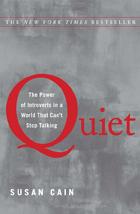A Review of "Quiet" by Susan Cain
 I am not sure how to introduce the book “Quiet” by Susan Cain. I don’t want to say it is about “introverts” because, as a professional behavior analyst and psychologist, I know the dangers to self and others of labeling. I don’t want to say it is about “quiet” people, as its title suggests, because that is just another label. Nor can I say it is about “exceptional” people because, as the author notes, up to half of the population is described in its pages. I opt instead to say that this is a book about people whose typical patterns of behaving are described by others, including the author, as “quiet.”
I am not sure how to introduce the book “Quiet” by Susan Cain. I don’t want to say it is about “introverts” because, as a professional behavior analyst and psychologist, I know the dangers to self and others of labeling. I don’t want to say it is about “quiet” people, as its title suggests, because that is just another label. Nor can I say it is about “exceptional” people because, as the author notes, up to half of the population is described in its pages. I opt instead to say that this is a book about people whose typical patterns of behaving are described by others, including the author, as “quiet.”
Here’s what I liked about the book: Over the course of its 200 or so pages, she not only describes these behavior patterns well, but also backs up her observations with her own personal experiences, psychological research, insightful observations, and reasonable advice to parents, bosses, and spouses. She notes the problems and inefficiencies that are created for as much as half of the workforce and school-aged populations by things like open work spaces, a team/group approach to everything, and a general tendency to not recognize individual differences in work, education, and personal development. She also gives sound behavioral advice, as toward the end of the book when she describes so nicely how the behavior of a child might be shaped into activities that the child initially might be hesitant about doing by fading in changes in small steps and encouraging (reinforcing) successive approximations to the final activity. For example, when going to the beach for the first time, she advises:
"Maybe they play in the sand for a few days with the ocean waves crashing at a safe distance. Then one day they approach the water’s edge, perhaps with the child riding on the parent’s shoulders. They wait for calm weather, or low tide, to immerse a toe, then a foot, then a knee. They don’t rush; every small step is a giant stride in a child’s world.”
What I didn’t like about this book was the heavy emphasis on labeling throughout. Labels like “smart” and “dumb” or “pretty” and “ugly” tend to create false dichotomies. Putting people into these categories ignores the vast continuum between the extremes. Everyone knows the continuum exists, but everyone also responds to the label. Like “introvert". Labels lead to stereotyping, so that others react to the label and not to the person. One unfortunate example of this that is reinforced in the book is the idea that people labeled “introvert” are smarter than everyone else. This theme recurs in several places and simply reinforces the stereotype that all introverts are smart, and, by implication, that extroverts are not. I wish that she had not done this.
Although labeling receives, to my thinking, too much emphasis in the book, “Quiet” indeed contains much that rings true to my behaviorist heart. For example, she cautions parents against forcing children into activities and behavior patterns inconsistent with their personal histories, suggesting instead that parents take into account their child’s “baseline” level when approaching these new activities. Not that she discourages children engaging in new things. Not at all, but she does suggest ways of rearranging environments to ease transitions. More generally, she sees a formative role for environments in establishing behavior:
“We often marvel at how introverted, geeky kids ‘blossom’ into secure and happy adults. We liken it to a metamorphosis. However, maybe it’s not the children who change but their environments.”
How true. And what a difference rearranging environments to optimize human performance can make in the lives of not only those whose environments change, but also those who parent or teach them, or who supervise their work.



